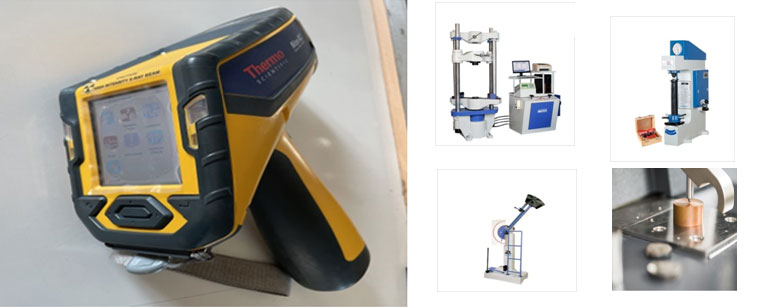Testing of Investment Castings
Chemical composition is the basic property of a metal cast part, which will directly affect the mechanical properties of products. So during investment casting process, material testing is a vital step for obtaining qualified products.
At D V Technocast foundry, the chemical composition of investment casting materials is precise tested by a spectrometer, it can accurately test out the composition of each element of the metal. And compare the testing result with the standard of material, if the value is within the range of chemical composition, it means the material of finished investment castings are qualified. We call this process “chemical analysis”.
As one of the leading investment casting foundries, how does our foundry to operate material testing? Firstly, before each batch of metal ingot comes into stock, the material factory will provide us the material certification, and to ensure its veracity, we will first cut a small piece to do chemical analysis by spectrum, and the testing result will prove if the material is approved. Secondly, we still need to do material inspection on the Melton metal before pouring. If there is any error, then the Melton metal could not be poured. Thirdly, after sample is completed, it will also be used to test thechemical composition.
Material Report
The results of the spectrometer analysis would be shown in a material report. In the report, you can see the standard material composition and the tested element value, by comparison, we can judge if the material is qualified. This material report will be delivered to our customer together with samples. Of course, when mass production, each batch of investment castings need to pass chemical analysis. This single summary makes it clear which alloy elements comprise a given production batch and whether this complies with the specification.
At D V Technocast, the spectrometer is linked to a computer. The reports are stored on the network so that the information is always available. Proper archiving of this information ensures the traceability of your product. Furthermore, we can also provide other testing’s of investment castings, such as dimensional testing, hardness testing, magnetic particle testing as well as other inspections. All these inspections will bring our customer a good quality product.
- UTM
- Hardness Testing
- Impact Test
- Spectro Analysis
- Positive metal index

Hardness Testing of Investment Castings
Hardness is a natural characteristic of investment casting materials, not a fundamental physical property. It is defined as the resistance to indentation, and it is determined by measuring the permanent depth of investment castings. Different cast alloys will show different hardness results. To add the wear resistance of investment castings, we can improve the hardness by heat treatment according to the requirement of our customers.
Hardness value of an investment cast part is obtained by measuring the depth or the area of product using different test methods. To ensure accurate testing results, the choice of testing area should be as flat as possible, and it is better to do hardness testing on different areas of the same part.
Hardness Testing Methods of Investment Castings
We use modern, automated hardness testers to test the hardness of your products. D V Techno Cast can perform a hardness analysis using the following methods:
Brinell Hardness
Brinell hardness testing is the oldest testing method that is still regularly used. The hardness tester used by this test is a spherical penetrating body. For Brinell hardness tests, a bullet, usually with a diameter of 10 mm, is pressed into the surface of investment casting to be tested. The pressing force can be adjusted depending on the material to be investigated. Based on the impression made on the surface of investment castings, the Brinell hardness is determined. The Brinell hardness value of investment castings will be shown in HB.
Rockwell Hardness
It uses a bullet-shaped or cone-shaped penetrating body. In a Rockwell test, hardness is interpreted as “resistance to local penetration”. The test determines the depth to which a penetrating body (spherical or cone-shaped) has penetrated after being tested with a standard testing load. This results in a hardness number that can be read off immediately after removing the testing load. Rockwell hardness is expressed as a number on a particular scale. The Rockwell scales used most often for steel are the B and C scales. The rockiness hardness value of investment castings will be shown in HRC.
Vickers Hardness
In this hardness test, a diamond pyramidal penetrating body with a top angle of 136° is pressed into the investment casting part with a given force (F). Within a few seconds, the force is built up and maintained for a period of between 10 and 15 seconds. After the removal of the force, both diagonals are measured using a measurement microscope. The hardness can be assessed by determining the surface area deflected using the Vickers formula.
Hardness must be 100% tested once there is any hardness requirement for investment casting.
